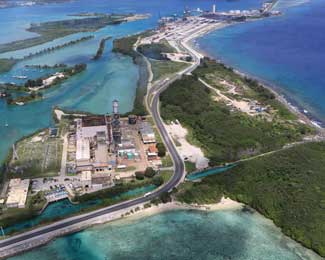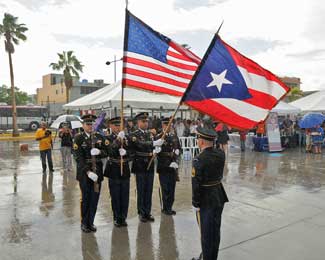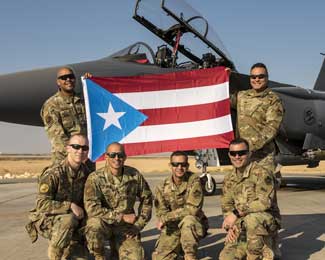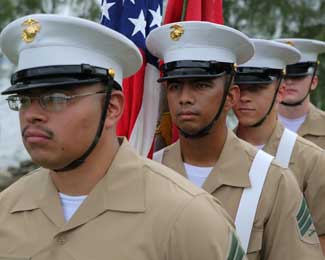US Territories Have High Rates of US Military Service, but Battle for Veterans’ Benefits
Before Alex Ortiz’s wife gave birth to their son, she left the couple’s Caribbean home and traveled some 1,600 miles to Rhode Island, where she had family, to deliver the baby. Ortiz had grown up in Puerto Rico before he joined the Army, and after he left active duty, the couple lived in Arizona before returning to his roots.
Ortiz medically retired from the Army, so he and his wife had health care through TRICARE—the military medical system that provides care to active-duty service members, retirees, and their families. But when his wife got pregnant, he realized his decision to start a family where he had grown up put him at a disadvantage. Although Ortiz was a U.S. citizen and a veteran, because he lived in Puerto Rico—a U.S. territory, rather than a state—he qualified for only a limited version of TRICARE. For his wife to give birth at a local hospital, the couple would have had to cough up tens of thousands of dollars, he said.

The Port of Guam as seen from the air in June 2021. Photo courtesy of the U.S. Coast Guard.
While the military benefits from high enlistment rates in U.S. territories like Puerto Rico and Guam, veterans who live in these places can face myriad challenges in accessing care and benefits after their service ends. These difficulties range from the logistical—things like inadequate internet access or time zone differences that can make phone calls to the continental U.S. tough—to the infrastructural—not enough health care facilities or veterans service representatives.
And crucially, people who live in U.S. territories or outlying areas—a handful of islands with various legal affiliations with the United States—are not afforded full citizenship rights. Laws written to benefit veterans often exclude veterans who live outside the continental U.S., and because these places do not have congressional voting representation, veterans have limited advocacy in Washington.
“Who are we supposed to report to?” says Ortiz, who now acts as an advocate for other veterans in Puerto Rico. “We don’t have anybody.”
As geopolitical attention has shifted to Asia, Guam’s strategic importance to the U.S. military has—again—risen to the country’s political forefront. So, too, has renewed interest in the thousands of veterans who live there and in other nonstates, such as Puerto Rico. Last year’s defense spending bill mandated a new advisory committee on veterans living in U.S. outlying areas and freely associated states. The committee met for the first time in December.
Award-Winning Journalism in Your Inbox
Veteran advocates are hopeful, but cautious, that things could change—and the challenges they face remain significant. Guam has the highest enlistment rate per capita in the country, and people from Puerto Rico are also disproportionately represented in the military. But veterans say that despite their commitment to country, their service—like their homelands—has, for decades, effectively been rendered second class after they leave the military.
“When you’re in the military, your network is set up for you,” says Kevin Miller, the associate national communications director at Disabled American Veterans. “You know where to go for everything. You know where your housing is, your bills are taken care of—everything’s set in place. But when you transition into the civilian world, you have to recreate that whole network without being given any set of instructions.”
Things like veterans’ health care and education benefits are specifically designed to ease that transition, helping veterans succeed as they move from the military to life in the civilian world. But for veterans in Puerto Rico, Guam, and other U.S. territories and outlying areas, where there are additional logistical challenges to accessing care and benefits, that transition—already jarring for so many veterans—can become even harder.
“How is one supposed to reintegrate and really become as independent and successful as possible if they don’t have the same resources as their counterparts who live in the continental U.S.?” Miller says.
‘That’s Not a Day Trip’
Just hours after Japanese forces bombed Pearl Harbor on Dec. 7, 1941, Japanese planes began strafing Guam, a U.S. territory, and bombed the island on and off for two days. On Dec. 10—Guam is on the other side of the international date line—nearly 6,000 Japanese troops came ashore. Mere hours later, the U.S. naval governor surrendered, ceding Guam to imperial forces. The island remained under Japanese control until the United States retook it in 1944.

The Puerto Rico National Guard celebrated Veterans Day in the municipality of Cataño, Puerto Rico, at the boardwalk of Cataño, in 2017. An honor guard marches in the rain. Photo by 1st Sgt. Waldemar Rivera, courtesy of the Puerto Rico National Guard.
Because of its location 4,000 miles west of Hawaii, Guam and the nearby Northern Mariana Islands have always been of critical strategic importance to both the United States and Asian countries. Today, nearly a third of the island is occupied by military bases—historic land that is now off-limits to many native CHamoru people. This year, the Marine Corps will begin relocating 5,000 troops from Okinawa to the island’s newest base, Camp Blaz.
But that doesn’t afford the veterans who live there any extra attention.
“You almost have to add ‘national security’ at the end of anything that you’re talking about with Guam to make the U.S. care about it,” says Mary Kate Soliva, a doctoral researcher and a CHamoru Army veteran with ties to Guam.
The military legacy is not confined to the land itself. One out of every eight adults from Guam has served in the military—the highest rate of service of anywhere in the United States. But updated numbers about how many veterans live on the island are hard to come by. While the U.S. Census Bureau’s most recent American Community Survey includes data about veterans by state, it does not include that data for Guam. Veterans Affairs’ National Center for Veterans Analysis and Statistics veteran population page similarly leaves information for Guam blank.
A 2014 survey found an estimated 24,000 veterans out of a population of just 160,000, but that figure is almost certainly low: Many veterans are not accounted for.
“There’s such limited research done on Guam,” Soliva says. “Why [does] this data either [not] exist, or it’s so hard to obtain it?”
Despite the high concentration of military service, veterans in Guam and other locations outside the continental United States face difficulty accessing care and benefits. The constellation of U.S. territories—such as Guam, Puerto Rico, and the U.S. Virgin Islands—and outlying areas and freely associated states—the Marshall Islands, Palau, and the Federated States of Micronesia—all contribute enlistees to the U.S. military but are governed by a patchwork of laws that contribute to disparate treatment and benefits.

Airmen of the Puerto Rico Air National Guard stand for a group photo Nov. 12, 2019, at the 332d Air Expeditionary Wing. Guam, Puerto Rico, and other U.S. territories have some of the highest rates of U.S. military enlistment. Photo by Senior Master Sgt. Ralph Branson, courtesy of the U.S. Air Force.
In Guam and Puerto Rico, for instance, veterans have access to VA health care. But retirees who, if they lived stateside, could get their care through TRICARE, the military’s health care system, have access to only a limited version of the program. In the Marshall Islands, Palau, and Micronesia, Veterans Affairs is forbidden by law from providing care to veterans who live there, because, while the islands are former U.S. colonies, they are not U.S. territories. VA does compensate these veterans for health care—but only care related to service-connected conditions.
Even in places where care is available, accessing it can be onerous. Guam has just one VA clinic—and veterans from the Northern Mariana Islands must fly to Guam for care. While VA does allow veterans to seek private health care through its community-based outpatient clinics program, Puerto Rico, Guam, and the Northern Mariana Islands face a dire shortage of healthcare providers, particularly specialists.
“Telehealth has been a big difference,” DAV’s Miller says. “[But] telehealth just doesn’t have the ability to replace everything when it comes to in-person treatment.” The time difference, particularly in the Pacific Islands, can make scheduling appointments nearly impossible.
As a result, many veterans from Micronesia and other Pacific Islands fly to Hawaii for care—a seven-hour one-way flight from Guam, for which veterans must front the cost. Veterans from Guam, the Northern Mariana Islands, and American Samoa are eligible for reimbursement—but veterans who fly from Micronesia, Palau, or the Marshall Islands are not. In June, Secretary of State Antony J. Blinken and Interior Secretary Deb Haaland asked congressional leaders to consider legislation changing that. Veterans may also need to pay for a spouse or caregiver to accompany them, and getting time off work and finding child care can be a challenge.
“The distance from Guam and Hawaii is actually greater than L.A. to New York,” Miller says. “That’s not a day trip.”
‘We’re Frustrated’
Veterans in Guam and elsewhere say they are skeptical about tying the political fortunes of veterans in U.S. territories and outlying areas too closely to the whims of the geopolitical spotlight—or even to the issue of health care exclusively.
Ortiz, in Puerto Rico, says that while many veterans on that island do have better access to VA care, they struggle with equal access to other benefits. The Puerto Rican government has a public advocate for veteran affairs, but with tens of thousands of veterans, the office is often overloaded with requests, Ortiz says.
“[It’s] like putting a bandage on a broken pipe that is pouring like thousands of gallons of water,” he says.

The Marine Corps Base Camp Blaz color guard stands in line prior to the national anthem at the Asan Landing Memorial Ceremony in Asan, Guam, July 14, 2022. The event marked the anniversary of Guam’s liberation from Japanese imperial forces in 1944. Photo by Lance Cpl. Garrett Gillespie, courtesy of the U.S. Marine Corps.
Across the island, a lack of infrastructure and a brain drain to the continental United States means the network of formal and informal advocates and assistance that veterans rely on is weaker. The island has just 16 people certified with the U.S. Court of Appeals for Veterans Claims. No schools in Puerto Rico have an on-campus coordinator for VetSuccess—a VA program to help veterans complete school. And Ortiz says, without voting representation in Congress, Puerto Rican veterans have little recourse in Washington.
“A lot of veterans … get to a point where they’re like, ‘They don’t care for me,’” Ortiz says. “We’re frustrated.”
This past June, VA Secretary Denis McDonough established a new advisory committee to provide the secretary guidance on veterans living in Puerto Rico, Guam, American Samoa, the Northern Mariana Islands, the U.S. Virgin Islands, Micronesia, the Marshall Islands, and Palau.
“VA’s top priority is to provide high-quality health care and benefits to all veterans, including [those] who live outside of the U.S., such as the veterans in the Freely Associated States of Marshall Islands, Palau, and Micronesia,” a VA representative told The War Horse. “VA and the Biden-Harris administration are actively working with our congressional partners to explore ways to better serve these veterans.”
Our Journalism Depends on Your Support
In mid-December, the advisory committee met for the first time to discuss the challenges these veterans face and talk about a way forward. Ortiz is one of three representatives on the committee from Puerto Rico.
“In my personal capacity, I’d like to emphasize the historic significance of this meeting,” Ortiz says. “This meeting was a pivotal step in acknowledging and resolving these long-standing issues, and I am optimistic about our continued progress in this vital area.”
Before the committee met, he said his personal experiences growing up on the island and returning as a veteran helped shape his understanding of what needs to change.
“For me, it’s extremely personal.”
This War Horse feature was reported by Sonner Kehrt, edited by Kelly Kennedy, fact-checked by Jess Rohan, and copy-edited by Mitchell Hansen-Dewar. Abbie Bennett wrote the headlines.





Comments are closed.